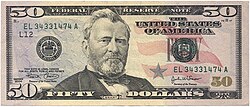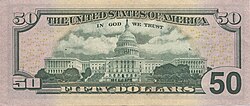| Country | United States of America |
|---|---|
| Value | $50 |
| Width | 156 mm |
| Height | 66.3 mm |
| Weight | Approx. 1.0 [1] g |
| Security features | Security fibers, watermark, security thread, color shifting ink, micro printing, raised printing, EURion constellation |
| Material used | 75% cotton 25% linen |
| Years of printing | 1861–present |
| Obverse | |
 | |
| Design | Ulysses S. Grant |
| Design date | 2004 |
| Reverse | |
 | |
| Design | United States Capitol |
| Design date | 2004 |
The United States fifty-dollar bill (US$50) is a denomination of United States currency. The 18th U.S. president (1869-1877), Ulysses S. Grant, is featured on the obverse, while the U.S. Capitol is featured on the reverse. All current-issue $50 bills are Federal Reserve Notes.
Contents
- History
- Large size notes
- Small size notes
- Series dates
- Proposed redesign
- References
- Further reading
- External links
As of December 2018, the average life of a $50 bill in circulation is 12.2 years before it is replaced due to wear. [2] Approximately 3.5% of all notes printed in 2019 were $50 bills. [3] They are delivered by Federal Reserve Banks in beige straps. Next to the United States two-dollar bill, the fifty-dollar bill has the lowest circulation of any U.S. denomination measured by volume, with 1.8 billion notes in circulation as of December 31, 2019. [4]






